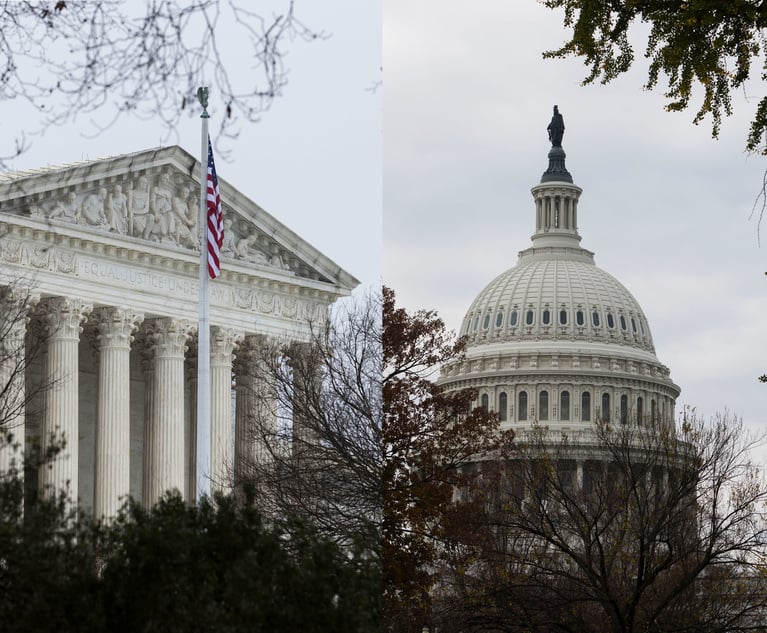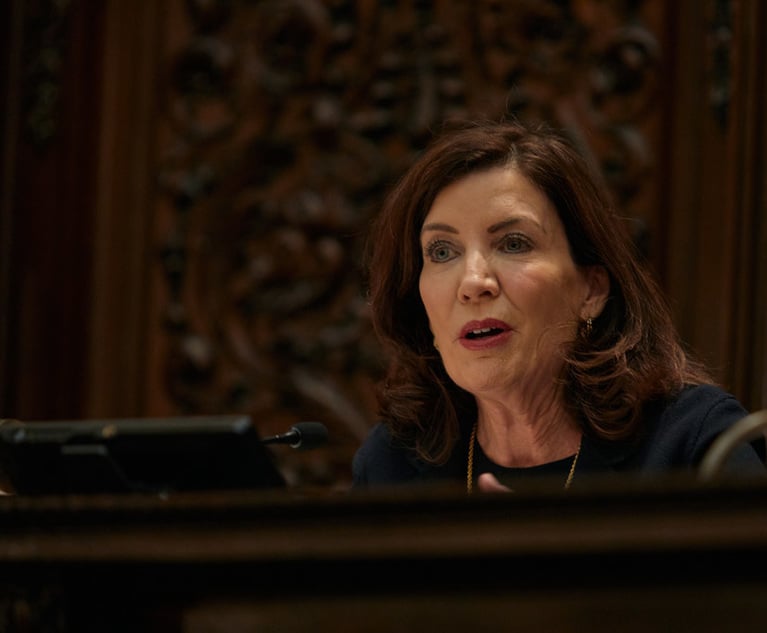Kavanaugh Breaks Ground for Future Campaigning by Supreme Court Nominees
"We're living in a world where you increasingly have to run for the Supreme Court," said Yale Law School's Akhil Amar, who testified in favor of Kavanaugh's confirmation. "I think we should expect to see more of that."
October 05, 2018 at 01:26 PM
4 minute read
U.S. Supreme Court nominee Brett Kavanaugh's unprecedented use of the news media—appearing on television and writing an op-ed—could open a door for future nominees to campaign on their own behalf across multimedia platforms for a seat on the nation's highest court.
Kavanaugh on Sept. 25 appeared with his wife on Fox television to defend himself against a sexual assault accusation by Christine Blasey Ford, a research psychologist in California. On Thursday night, just hours before a crucial Senate vote on his nomination, Kavanaugh penned an op-ed article at The Wall Street Journal in an attempt to reassure Americans he would be a neutral justice despite his sharply partisan tirade against Senate Democrats and the “left” during a hearing on the accusation.
In both instances, the Republican nominee turned to media closely associated with a conservative editorial viewpoint and sought the widest possible distribution of his views in a strategic effort to boost his nomination.
“We're living in a world where you increasingly have to run for the Supreme Court,” said Yale Law School's Akhil Amar, who testified in favor of Kavanaugh's confirmation. “I think we should expect to see more of that. I think this is the wave of the future.”
The concern with “election” of Supreme Court nominees emerged most dramatically during the 1987 confirmation hearings for Ronald Reagan nominee Robert Bork. The Bork hearings, many court scholars and others believe, marked the true beginning of the highly politicized Senate confirmation process. Bork gave some press interviews before his hearing—pencil-and-pad meetings with the press, not television.
Bork's televised hearings and the intense efforts by special interest groups who spent millions of dollars on campaign-style ads pulled the public into the confirmation process in ways and to a degree never before experienced. From water coolers to dinner tables, the public debated everything from whether a right to privacy existed to the strangeness of Bork's beard.
At one point during those hearings, Lloyd Cutler, a former Democratic White House counsel who testified for Bork, said: “We're getting perilously close to electing a Supreme Court justice.”
 Robert Bork, appearing at his confirmation hearing in 1987. (Photo: Sue Moniak)
Robert Bork, appearing at his confirmation hearing in 1987. (Photo: Sue Moniak)
Since the Bork nomination and defeat, the White House has learned about image-making and what to do with image-making when the image “doesn't go your way,” said political scientist Richard Davis of Brigham Young University and author of “Electing Justice and Supreme Democracy.” “That's what we're seeing with Kavanaugh in an unprecedented way.”
In the 1991 embattled nomination of Clarence Thomas, Davis said, the White House did not do “the full court press.” But with Kavanaugh, he added, the tactics changed to make sure there is an appeal to the public.
“What's interesting, too—and I don't know how likely this will be in the future—we're also seeing that President Trump and Republicans know this [nomination] is a base motivator and that is something I've not seen quite as explicit before,” Davis said.
The Thomas nomination was a base motivator for his opposition and resulted in the so-called Year of the Woman at the election polls, Davis added. This time, the White House's own nomination is being used to motivate its own base.
Over the years, Supreme Court justices appeared to time their retirements, when possible, to avoid election years, said Davis. But he wonders now if the choice will be for election years in order to have the kind of political impact being seen now.
“I think we're having some potential models for the future that really worry me,” Davis said. “A nominee campaigned for himself instead of allowing others to do that and sort of nakedly putting himself forward to get support from the public and wrapping that up in partisan base activation. These are all going in the wrong direction.”
Read more:
This content has been archived. It is available through our partners, LexisNexis® and Bloomberg Law.
To view this content, please continue to their sites.
Not a Lexis Subscriber?
Subscribe Now
Not a Bloomberg Law Subscriber?
Subscribe Now
NOT FOR REPRINT
© 2025 ALM Global, LLC, All Rights Reserved. Request academic re-use from www.copyright.com. All other uses, submit a request to [email protected]. For more information visit Asset & Logo Licensing.
You Might Like
View All
Roberts Calls Court's Relationship With Congress 'Strained.' Who's to Blame?

Judicial Conference Declines Democratic Request to Refer Justice Thomas to DOJ

Senate Judiciary Dems Release Report on Supreme Court Ethics

Reported Refusal to Officiate Gay Wedding Prompts Review by NY Judicial Misconduct Watchdog
Trending Stories
- 1'David and Goliath' Dispute Between Software Developers Ends in $24M Settlement
- 2Supreme Court Takes Up the Corporate Transparency Act: Recent Litigation and Potential Next Steps
- 3Brogdon: The Final Nail in Corbin’s Coffin in Premises Cases
- 4What to Know About the New 'Overlapping Directorship' Antitrust Development
- 5'Quiet, Appropriate End:' NY Court of Appeals Formally Removes Erin Gall From Bench
Who Got The Work
Michael G. Bongiorno, Andrew Scott Dulberg and Elizabeth E. Driscoll from Wilmer Cutler Pickering Hale and Dorr have stepped in to represent Symbotic Inc., an A.I.-enabled technology platform that focuses on increasing supply chain efficiency, and other defendants in a pending shareholder derivative lawsuit. The case, filed Oct. 2 in Massachusetts District Court by the Brown Law Firm on behalf of Stephen Austen, accuses certain officers and directors of misleading investors in regard to Symbotic's potential for margin growth by failing to disclose that the company was not equipped to timely deploy its systems or manage expenses through project delays. The case, assigned to U.S. District Judge Nathaniel M. Gorton, is 1:24-cv-12522, Austen v. Cohen et al.
Who Got The Work
Edmund Polubinski and Marie Killmond of Davis Polk & Wardwell have entered appearances for data platform software development company MongoDB and other defendants in a pending shareholder derivative lawsuit. The action, filed Oct. 7 in New York Southern District Court by the Brown Law Firm, accuses the company's directors and/or officers of falsely expressing confidence in the company’s restructuring of its sales incentive plan and downplaying the severity of decreases in its upfront commitments. The case is 1:24-cv-07594, Roy v. Ittycheria et al.
Who Got The Work
Amy O. Bruchs and Kurt F. Ellison of Michael Best & Friedrich have entered appearances for Epic Systems Corp. in a pending employment discrimination lawsuit. The suit was filed Sept. 7 in Wisconsin Western District Court by Levine Eisberner LLC and Siri & Glimstad on behalf of a project manager who claims that he was wrongfully terminated after applying for a religious exemption to the defendant's COVID-19 vaccine mandate. The case, assigned to U.S. Magistrate Judge Anita Marie Boor, is 3:24-cv-00630, Secker, Nathan v. Epic Systems Corporation.
Who Got The Work
David X. Sullivan, Thomas J. Finn and Gregory A. Hall from McCarter & English have entered appearances for Sunrun Installation Services in a pending civil rights lawsuit. The complaint was filed Sept. 4 in Connecticut District Court by attorney Robert M. Berke on behalf of former employee George Edward Steins, who was arrested and charged with employing an unregistered home improvement salesperson. The complaint alleges that had Sunrun informed the Connecticut Department of Consumer Protection that the plaintiff's employment had ended in 2017 and that he no longer held Sunrun's home improvement contractor license, he would not have been hit with charges, which were dismissed in May 2024. The case, assigned to U.S. District Judge Jeffrey A. Meyer, is 3:24-cv-01423, Steins v. Sunrun, Inc. et al.
Who Got The Work
Greenberg Traurig shareholder Joshua L. Raskin has entered an appearance for boohoo.com UK Ltd. in a pending patent infringement lawsuit. The suit, filed Sept. 3 in Texas Eastern District Court by Rozier Hardt McDonough on behalf of Alto Dynamics, asserts five patents related to an online shopping platform. The case, assigned to U.S. District Judge Rodney Gilstrap, is 2:24-cv-00719, Alto Dynamics, LLC v. boohoo.com UK Limited.
Featured Firms
Law Offices of Gary Martin Hays & Associates, P.C.
(470) 294-1674
Law Offices of Mark E. Salomone
(857) 444-6468
Smith & Hassler
(713) 739-1250










